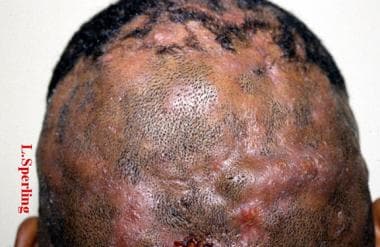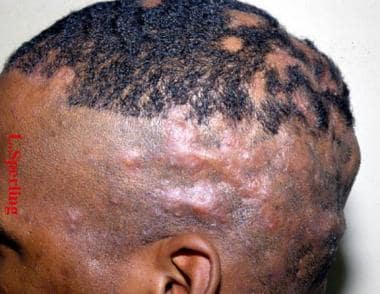Hoffman E. Perifolliculitis capitis abscedens et suffodiens: case presentation. Dermatol Zeitschrift (Berlin). 1908. 15:122-3.
Spitzer L. Dermatitis follicularis et perifollicularis conglobata. Dermatol Zeitschrift (Berlin). 1903. 10:109-20.
Varshney N, Al Hammadi A, Sam H, Watters AK. Perifolliculitis capitis abscedens et suffodiens in an 18-year-old Aboriginal Canadian patient: case report and review of the literature. J Cutan Med Surg. 2007 Jan-Feb. 11(1):35-9. [QxMD MEDLINE Link].
Stites PC, Boyd AS. Dissecting cellulitis in a white male: a case report and review of the literature. Cutis. 2001 Jan. 67(1):37-40. [QxMD MEDLINE Link].
Gaopande VL, Kulkarni MM, Joshi AR, Dhande AN. Perifolliculitis Capitis Abscedens et Suffodiens in a 7 Years Male: A Case Report with Review of Literature. Int J Trichology. 2015 Oct-Dec. 7 (4):173-5. [QxMD MEDLINE Link].
Badaoui A, Reygagne P, Cavelier-Balloy B, Pinquier L, Deschamps L, Crickx B, et al. Dissecting cellulitis of the scalp: a retrospective study of 51 patients and review of literature. Br J Dermatol. 2016 Feb. 174 (2):421-3. [QxMD MEDLINE Link].
Tran AX, Lefante JJ, Murina A. Risk factors for dissecting cellulitis of the scalp: A case-control study. J Am Acad Dermatol. 2022 Apr. 86 (4):941-943. [QxMD MEDLINE Link].
Chicarilli ZN. Follicular occlusion triad: hidradenitis suppurativa, acne conglobata, and dissecting cellulitis of the scalp. Ann Plast Surg. 1987 Mar. 18(3):230-7. [QxMD MEDLINE Link].
Zisova L, Sakakushev B. Acne tetrad in a family. Folia Med (Plovdiv). 1994. 36(4):51-7. [QxMD MEDLINE Link].
Maintz L, Betz RC, Allam JP, Wenzel J, Jaksche A, Friedrichs N, et al. Keratitis-ichthyosis-deafness syndrome in association with follicular occlusion triad. Eur J Dermatol. 2005 Sep-Oct. 15(5):347-52. [QxMD MEDLINE Link].
Montgomery JR, White TW, Martin BL, Turner ML, Holland SM. A novel connexin 26 gene mutation associated with features of the keratitis-ichthyosis-deafness syndrome and the follicular occlusion triad. J Am Acad Dermatol. 2004 Sep. 51(3):377-82. [QxMD MEDLINE Link].
Prasad SC, Bygum A. Successful treatment with alitretinoin of dissecting cellulitis of the scalp in keratitis-ichthyosis-deafness syndrome. Acta Derm Venereol. 2013 Jul 6. 93(4):473-4. [QxMD MEDLINE Link].
Koshelev MV, Garrison PA, Wright TS. Concurrent hidradenitis suppurativa, inflammatory acne, dissecting cellulitis of the scalp, and pyoderma gangrenosum in a 16-year-old boy. Pediatr Dermatol. 2014 Jan-Feb. 31 (1):e20-1. [QxMD MEDLINE Link].
Syed TA, Ul Abideen Asad Z, Salem G, Garg K, Rubin E, Agudelo N. Dissecting Cellulitis of the Scalp: A Rare Dermatological Manifestation of Crohn's Disease. ACG Case Rep J. 2018. 5:e8. [QxMD MEDLINE Link].
Segurado-Miravalles G, Camacho-Martínez FM, Arias-Santiago S, Serrano-Falcón C, Serrano-Ortega S, Rodrigues-Barata R, et al. Epidemiology, clinical presentation and therapeutic approach in a multicentre series of dissecting cellulitis of the scalp. J Eur Acad Dermatol Venereol. 2017 Apr. 31 (4):e199-e200. [QxMD MEDLINE Link].
Kurtzman DJB, Alexander CE. Image Gallery: Dissecting cellulitis of the scalp following anabolic steroid use. Br J Dermatol. 2017 Oct. 177 (4):e160. [QxMD MEDLINE Link].
Curry SS, Gaither DH, King LE Jr. Squamous cell carcinoma arising in dissecting perifolliculitis of the scalp. A case report and review of secondary squamous cell carcinomas. J Am Acad Dermatol. 1981 Jun. 4(6):673-8. [QxMD MEDLINE Link].
Sivakumaran S, Meyer P, Burrows NP. Dissecting folliculitis of the scalp with marginal keratitis. Clin Exp Dermatol. 2001 Sep. 26(6):490-2. [QxMD MEDLINE Link].
Benvenuto ME, Rebora A. Fluctuant nodules and alopecia of the scalp. Perifolliculitis capitis abscedens et suffodiens. Arch Dermatol. 1992 Aug. 128(8):1115-7, 1118-9. [QxMD MEDLINE Link].
Ramesh V. Dissecting cellulitis of the scalp in 2 girls. Dermatologica. 1990. 180(1):48-50. [QxMD MEDLINE Link].
Tosti A, Torres F, Miteva M. Dermoscopy of Early Dissecting Cellulitis of the Scalp Simulates Alopecia Areata. Actas Dermosifiliogr. 2012 Jul 30. [QxMD MEDLINE Link].
Segurado-Miravalles G, Camacho-Martınez F, Arias-Santiago S, Rodrigues-Barata R, Serrano-Falcón C, Moreno-Arrones OM, et al. Trichoscopy of dissecting cellulitis of the scalp: Exclamation mark hairs and white dots as markers of disease chronicity. J Am Acad Dermatol. 2016 Dec. 75 (6):1267-1268. [QxMD MEDLINE Link].
Verzì AE, Lacarrubba F, Micali G. Heterogeneity of trichoscopy findings in dissecting cellulitis of the scalp: correlation with disease activity and duration. Br J Dermatol. 2017 Dec. 177 (6):e331-e332. [QxMD MEDLINE Link].
Salim A, David J, Holder J. Dissecting cellulitis of the scalp with associated spondylarthropathy: case report and review. J Eur Acad Dermatol Venereol. 2003 Nov. 17(6):689-91. [QxMD MEDLINE Link].
Libow LF, Friar DA. Arthropathy associated with cystic acne, hidradenitis suppurativa, and perifolliculitis capitis abscedens et suffodiens: treatment with isotretinoin. Cutis. 1999 Aug. 64(2):87-90. [QxMD MEDLINE Link].
Miletta NR, Schwartz C, Sperling L. Tinea capitis mimicking dissecting cellulitis of the scalp: a histopathologic pitfall when evaluating alopecia in the post-pubertal patient. J Cutan Pathol. 2014 Jan. 41 (1):2-4. [QxMD MEDLINE Link].
Abdennader S, Vignon-Pennamen MD, Hatchuel J, Reygagne P. Alopecic and aseptic nodules of the scalp (pseudocyst of the scalp): a prospective clinicopathological study of 15 cases. Dermatology. 2011 Feb. 222(1):31-5. [QxMD MEDLINE Link].
Sperling LC. Scarring alopecia and the dermatopathologist. J Cutan Pathol. 2001 Aug. 28(7):333-42. [QxMD MEDLINE Link].
Bjellerup M, Wallengren J. Familial perifolliculitis capitis abscedens et suffodiens in two brothers successfully treated with isotretinoin. J Am Acad Dermatol. 1990 Oct. 23(4 Pt 1):752-3. [QxMD MEDLINE Link].
Koca R, Altinyazar HC, Ozen OI, Tekin NS. Dissecting cellulitis in a white male: response to isotretinoin. Int J Dermatol. 2002 Aug. 41(8):509-13. [QxMD MEDLINE Link].
Omulecki A, Dabkowski J, Zak-Prelich M. Perifolliculitis capitis abscedens et suffodiens--a case report. Med Sci Monit. 2000 May-Jun. 6(3):602-4. [QxMD MEDLINE Link].
Schewach-Millet M, Ziv R, Shapira D. Perifolliculitis capitis abscedens et suffodiens treated with isotretinoin (13-cis-retinoic acid). J Am Acad Dermatol. 1986 Dec. 15(6):1291-2. [QxMD MEDLINE Link].
Jacobs F, Metzler G, Kubiak J, et al. New approach in combined therapy of perifolliculitis capitis abscedens et suffodiens. Acta Derm Venereol. Oct 2011. 91(6):726-7.
Karpouzis A, Giatromanolaki A, Sivridis E, Kouskoukis C. Perifolliculitis capitis abscedens et suffodiens successfully controlled with topical isotretinoin. Eur J Dermatol. 2003 Mar-Apr. 13(2):192-5. [QxMD MEDLINE Link].
Georgala S, Korfitis C, Ioannidou D, Alestas T, Kylafis G, Georgala C. Dissecting cellulitis of the scalp treated with rifampicin and isotretinoin: case reports. Cutis. 2008 Sep. 82(3):195-8. [QxMD MEDLINE Link].
Bolz S, Jappe U, Hartschuh W. Successful treatment of perifolliculitis capitis abscedens et suffodiens with combined isotretinoin and dapsone. J Dtsch Dermatol Ges. 2008 Jan. 6(1):44-7. [QxMD MEDLINE Link].
Greenblatt DT, Sheth N, Teixeira F. Dissecting cellulitis of the scalp responding to oral quinolones. Clin Exp Dermatol. 2008 Jan. 33(1):99-100. [QxMD MEDLINE Link].
Berne B, Venge P, Ohman S. Perifolliculitis capitis abscedens et suffodiens (Hoffman). Complete healing associated with oral zinc therapy. Arch Dermatol. 1985 Aug. 121(8):1028-30. [QxMD MEDLINE Link].
Kobayashi H, Aiba S, Tagami H. Successful treatment of dissecting cellulitis and acne conglobata with oral zinc. Br J Dermatol. 1999 Dec. 141(6):1137-8. [QxMD MEDLINE Link].
Brandt HR, Malheiros AP, Teixeira MG, Machado MC. Perifolliculitis capitis abscedens et suffodiens successfully controlled with infliximab. Br J Dermatol. 2008 Aug. 159(2):506-7. [QxMD MEDLINE Link].
Navarini AA, Trüeb RM. 3 cases of dissecting cellulitis of the scalp treated with adalimumab: control of inflammation within residual structural disease. Arch Dermatol. 2010 May. 146(5):517-20. [QxMD MEDLINE Link].
Sukhatme SV, Lenzy YM, Gottlieb AB. Refractory dissecting cellulitis of the scalp treated with adalimumab. J Drugs Dermatol. 2008 Oct. 7(10):981-3. [QxMD MEDLINE Link].
Wollina U, Gemmeke A, Koch A. Dissecting Cellulitis of the Scalp Responding to Intravenous Tumor Necrosis Factor-alpha Antagonist. J Clin Aesthet Dermatol. 2012 Apr. 5(4):36-9. [QxMD MEDLINE Link]. [Full Text].
Wollina U, Gemmeke A, Koch A. Dissecting Cellulitis of the Scalp Responding to Intravenous Tumor Necrosis Factor-alpha Antagonist. J Clin Aesthet Dermatol. 2012 Apr. 5(4):36-9. [QxMD MEDLINE Link]. [Full Text].
Mansouri Y, Martin-Clavijo A, Newsome P, Kaur MR. Dissecting cellulitis of the scalp treated with tumour necrosis factor-α inhibitors: experience with two agents. Br J Dermatol. 2015 Nov 2. [QxMD MEDLINE Link].
Takahashi T, Yamasaki K, Terui H, et al. Perifolliculitis capitis abscedens et suffodiens treatment with tumor necrosis factor inhibitors: A case report and review of published cases. J Dermatol. 2019 Sep. 46 (9):802-807. [QxMD MEDLINE Link].
Asemota E, Chang YC, Goldberg LJ. Innovative Management of Recalcitrant Dissecting Cellulitis With Compression Therapy. JAMA Dermatol. 2016 Nov 1. 152 (11):1280-1281. [QxMD MEDLINE Link].
Glass LF, Berman B, Laub D. Treatment of perifolliculitis capitis abscedens et suffodiens with the carbon dioxide laser. J Dermatol Surg Oncol. 1989 Jun. 15(6):673-6. [QxMD MEDLINE Link].
Boyd AS, Binhlam JQ. Use of an 800-nm pulsed-diode laser in the treatment of recalcitrant dissecting cellulitis of the scalp. Arch Dermatol. 2002 Oct. 138(10):1291-3. [QxMD MEDLINE Link].
Chui CT, Berger TG, Price VH, Zachary CB. Recalcitrant scarring follicular disorders treated by laser-assisted hair removal: a preliminary report. Dermatol Surg. 1999 Jan. 25(1):34-7. [QxMD MEDLINE Link].
Krasner BD, Hamzavi FH, Murakawa GJ, Hamzavi IH. Dissecting cellulitis treated with the long-pulsed Nd:YAG laser. Dermatol Surg. 2006 Aug. 32(8):1039-44. [QxMD MEDLINE Link].
McMullan FH, Zeligman I. Perifolliculitis capitis abscedens et suffodiens; its successful treatment with x-ray epilation. AMA Arch Derm. 1956 Mar. 73(3):256-63. [QxMD MEDLINE Link].
Chinnaiyan P, Tena LB, Brenner MJ, Welsh JS. Modern external beam radiation therapy for refractory dissecting cellulitis of the scalp. Br J Dermatol. 2005 Apr. 152(4):777-9. [QxMD MEDLINE Link].
Paul S, Bach D, LeBoeuf NR, Devlin PM, Lipworth AD. Successful use of brachytherapy for a severe hidradenitis suppurativa variant. Dermatol Ther. 2016 Nov. 29 (6):455-458. [QxMD MEDLINE Link].
Bellew SG, Nemerofsky R, Schwartz RA, Granick MS. Successful treatment of recalcitrant dissecting cellulitis of the scalp with complete scalp excision and split-thickness skin graft. Dermatol Surg. 2003 Oct. 29(10):1068-70. [QxMD MEDLINE Link].
Moschella SL, Klein MH, Miller RJ. Perifolliculitis capitis abscedens et suffodiens. Report of a successful therapeutic scalping. Arch Dermatol. 1967 Aug. 96(2):195-7. [QxMD MEDLINE Link].
Hintze JM, Howard BE, Donald CB, Hayden RE. Surgical Management and Reconstruction of Hoffman's Disease (Dissecting Cellulitis of the Scalp). Case Rep Surg. 2016. 2016:2123037. [QxMD MEDLINE Link].
Cui X, Zhu J, Yao X, Zhu W, Xu P, Wu X. Photodynamic therapy combined with dermatosurgical approach for Perifolliculitis Capitis Abscedens et Suffodiens. Photodiagnosis Photodyn Ther. 2020 Jun. 30:101767. [QxMD MEDLINE Link].
Shaffer N, Billick RC, Srolovitz H. Perifolliculitis capitis abscedens et suffodiens. Resolution with combination therapy. Arch Dermatol. 1992 Oct. 128(10):1329-31. [QxMD MEDLINE Link].
Dubost-Brama A, Delaporte E, Alfandari S, Piette F, Bergoend H. [Perifolliculitis capitis abscedens and suffidiens. Efficacy of isotretinoin]. Ann Dermatol Venereol. 1994. 121(4):328-30. [QxMD MEDLINE Link].
Babalola F, Chima M, Jobarteh R, Gottlieb A. Refractory Dissecting Cellulitis of the Scalp Treated With Risankizumab. J Drugs Dermatol. 2022 Mar 1. 21 (3):313-314. [QxMD MEDLINE Link].
Liu Y, Ma Y, Xiang LH. Successful treatment of recalcitrant dissecting cellulitis of the scalp with ALA-PDT: case report and literature review. Photodiagnosis Photodyn Ther. 2013 Dec. 10(4):410-3. [QxMD MEDLINE Link].
 Perifolliculitis capitis abscedens et suffodiens in a black man. Painful cutaneous nodules and patchy alopecia.
Perifolliculitis capitis abscedens et suffodiens in a black man. Painful cutaneous nodules and patchy alopecia.
 Side view of a black man with painful cutaneous nodules and patchy alopecia, characteristic of perifolliculitis capitis abscedens et suffodiens.
Side view of a black man with painful cutaneous nodules and patchy alopecia, characteristic of perifolliculitis capitis abscedens et suffodiens.









